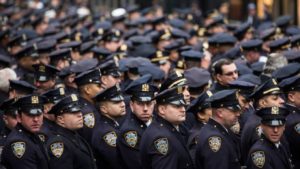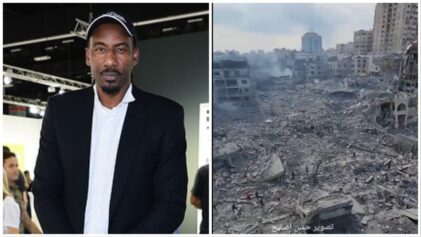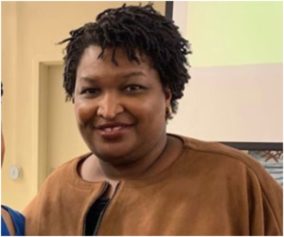
A report from The Intercept found that plainclothes officers in the NYPD are 6 percent of the force but account for nearly one third of police killings. (Photo: Andrew Burton/Getty)
Plainclothes or undercover police officers are engaged in an inordinate amount of killings, suggesting there is a fundamental problem with the practice of placing law enforcement out of uniform.
In the New York Police Department, plainclothes officers are involved in fatal shootings far in excess of their numbers on the force, as The Intercept reported. An analysis of 174 fatal shootings by NYPD on-duty officers since 2000 found that plainclothes or undercover officers, who are approximately 6 percent of the force, were involved in nearly one third — 31 percent — or 54 of those killings.
According to a 2016 report from the NYPD, plainclothes cops accounted for nearly half of officers involved in “adversarial conflicts” in which police are in confrontation with a suspect and intentionally discharge a weapon. Specialty units such as anti-crime units, which proactively pursue people on the street, claim one-third of these gun discharges. These elite units of plainclothes officers, unlike their uniformed counterparts, do not respond to 911 calls but instead pursue violent criminal activity while or before it takes place. Typically, undercover officers patrol without body cameras, use unmarked vehicles, and operate without accountability. Further, unlike beat NYPD cops who may form relations with the community, plainclothes police are known to instigate, harass and engage in aggressive and dangerous behavior.
Plainclothes officers have long been associated with death in the Black community, failing to protect and placing Black lives in harm’s way. In the 1960s, the NYPD used Black undercover officers to infiltrate Black radical organizations through the department’s clandestine operations, the Bureau of Special Services, or BOSS. The NYPD was monitoring Malcolm X up until his assassination. Undercover agent Gene Roberts was a member of Malcolm X’s OAAU and the minister’s chief of security. Known as “Brother Gene,” he unsuccessfully administered CPR to the fallen leader at the Audubon Ballroom in Harlem. This man who betrayed Malcolm went on to infiltrate the Black Panthers. FBI agents worked undercover in the Nation of Islam, including John Ali, the NOI national secretary. Another undercover NYPD agent, Ray Wood, who infiltrated the Bronx chapter of CORE, was reportedly seen running out of the Audubon at the time of the assassination.

Graphic: Moiz Syed/The Intercept
Over the past few decades, plainclothes officers have been involved in the slayings of a number of Black men. For example, in 1999, members of the infamous NYPD street crimes unit killed Amadou Diallo in a hail of 41 bullets because they reportedly thought he was a suspect and mistook his wallet for a gun. Although the NYPD disbanded the unit, the brutality against Black people continued unabated.
Another casualty of undercover police was Sean Bell, who was shot to death in 2006 at his bachelor party, hours before his wedding. Undercover officers opened fire on Bell’s car with 50 shots, killing Bell, 23 and injuring two others. In 2013, Kimani Gray, 16, was fatally shot by members of an anti-crime unit in Crown Heights. The officer who choked Eric Garner to death in 2014 on Staten Island on suspicion of selling untaxed “loosie” cigarettes was working in plainclothes as well.
The Baltimore Police Department abolished plainclothes policing because of a “cutting corners mindset” among crime fighting units, as the Baltimore Sun reported, and as a result of federal indictments against seven officers who were engaging in robbery and extortion of Baltimore residents, filing false police reports and fraudulently collecting overtime pay. Members of the Gun Trace Task Force acted as both cops and robbers, stealing large amounts of money from Black men with no recourse. Such units charged with fighting and reducing crime have violated the rights of the public.
Undercover police are also a common fixture of antifascist protests, infiltrating crowds and student activist groups that oppose the presence of white supremacist hate groups on college campuses. As white extremist groups continue their demonstrations, police arrest anti-racist protesters, sometimes at home or their place of work, in an effort to intimidate left-wing and racial justice activists. This as campus, state and local police face accusations they protect and collaborate with white supremacists. For example, when white supremacist Richard Spencer was scheduled for a speaking engagement at Michigan State University in March, 200 officers from eight different departments were present that day, including nine undercover officers, of whom two were campus police.
As plainclothes officers violate the civil rights of Black people, sometimes they are taken to court and made to answer for their crimes. In 2014, a federal jury awarded art student Jordan Miles, 22, $119,000 for a 2010 false arrest and beating from three white Pittsburgh police officers. Because of his race and dreadlocks, the police, who reportedly assumed Miles was a drug dealer, rolled up in an unmarked car, without identifying themselves, asking for drugs, money and a gun. Jacqueline Little, a Philadelphia resident and IRS employee, sued the city and three plainclothes officers who pulled her over, claimed she had drugs in her possession, and falsely arrested her. She admitted herself to a hospital after sustaining injuries from the tight handcuffs while in police custody. Meanwhile, Glen Grays, a New York postal worker, was nearly struck while making a delivery by an unmarked NYPD police vehicle, then arrested in his uniform. The officers involved had a history of various civil rights complaints filed against them.
It is clear that plainclothes police are a problem, particularly where Black people are concerned.


